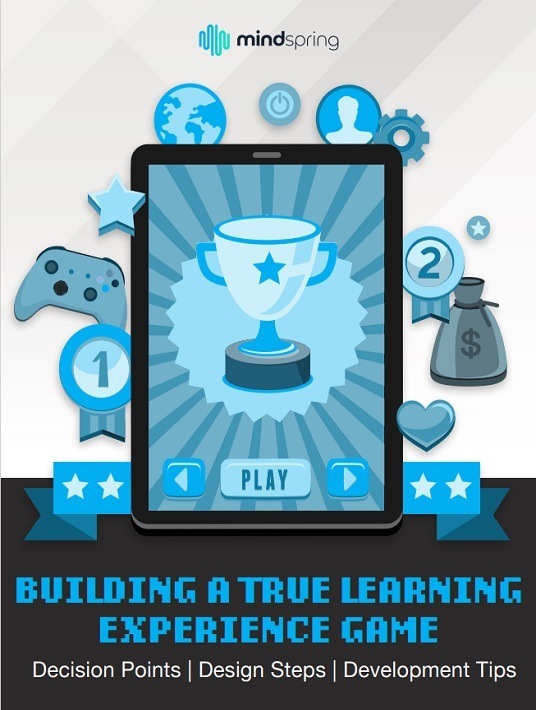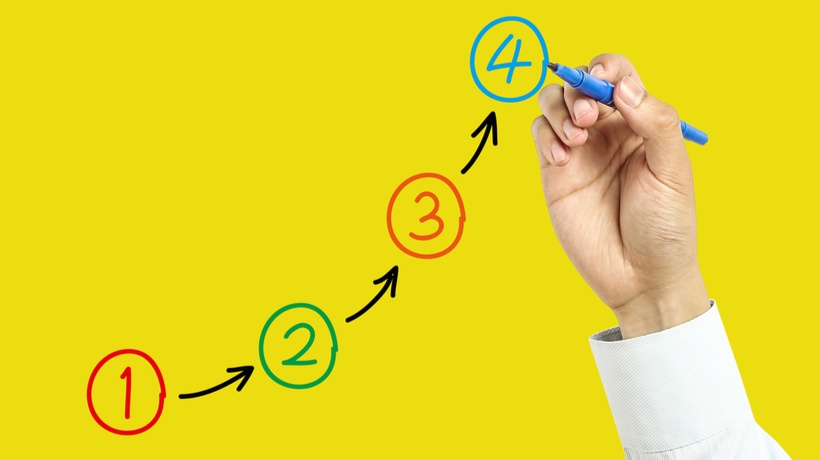Four Phases Of Building A True Game For Workforce Development
This article is part of a series on building a true training game to increase managers’ understanding of corporate finance. What you are about to read is a fable. The company, AshCom, is fictional, but the learning challenges faced by Kathryn, AshCom’s CLO, and her team are real and commonly shared by learning teams in large organizations. It is our hope that you will be able to connect with the characters, their challenges, and the solutions they discover. We also invite you to read the first eBook in the series.

The Growing To-Do List
Flip…flip…flip. Adeena shuffled through her spiral notebook, searching for the sheet that listed her to-dos. She landed on the page and drew a line through three of the tasks she had completed. Her sense of accomplishment was short-lived. With determination, she added five more items at the end of the growing list.
Kathryn, the Chief Learning Officer of AshCom, put her in charge of developing a financial literacy true game for the managers of the 7,000-person company. So many details threatened to distract her from the main purpose of the game, which was to create a world-class learning experience for the managers that would increase their understanding of AshCom’s financial system and motivate them to make stronger day-to-day financial decisions.
The game structure would be a combination of role-play and strategy. Players would be given a role in leading AshCom’s financial team with the goal of putting the company in the strongest possible financial position. The key motivators would be ownership, social influence, and accomplishment.
At Adeena’s recommendation, AshCom partnered with Inno-Versity to help them design, build, test, and roll out the game. It would require months of work, hundreds of meetings, and thousands of emails between her team and the team at Inno-Versity. The first steps were getting through the price and timeline negotiation. When the contract was completed and signed, Adeena worked with Inno-Versity to set up a kick-off meeting, a regular rhythm of meetings, and a feedback structure.
Adeena was challenged by the sheer number of moving parts to manage, but her project management skills and organization abilities served her well. She felt empowered by the trust Kathryn and the learning team at AshCom extended to her. Her fellow learning team members were willing to help whenever she needed it. Kathryn supported her by being a sounding board when she was stuck on a problem or just a bit overwhelmed. Sometimes, a few words of encouragement from Kathryn made all the difference.
True Game Development Structure
The next six months were intense but followed a process built by the Inno-Versity team, something they had done with previous clients for whom they had built a true game. The structure has four focal points in sequence:
- Instructional Design And Learning Science
- Game Building
- Piloting
- Marketing
Adeena and Kathryn appreciated Inno-Versity’s emphasis on the need to begin with learning before diving into the details, mechanics, and rules of the game. They began with a Needs Analysis exercise, kicked off when the team from Inno-Versity visited AshCom’s corporate headquarters in Minneapolis. Rebecca, the learning lead at Inno-Versity, brought several members of her team including Lonna, an instructional designer, Wendy, a project manager, and Jake from their game team.
Rebecca explained that as they moved through this four-step process, different components of the project would take precedence. They would start with learning which was why the initial Inno-Versity team would be weighted toward learning science. Once they moved to the second stage of game building, the game team would take a bigger role. Jake, the game experience, joined in the initial meetings to develop a relationship with Adeena and make sure he was fully up to speed on the learning goals.
1. Instructional Design And Learning Science
The team from AshCom and the team from Inno-Versity mutually agreed that it would be important to begin with a Needs Analysis, which had seven steps.
- Creating a Curriculum Map which provided a learning team with a strong sense of where they are, where they are going, and what comes next. It’s all about giving visibility so that a team can “see.” A good curriculum map creates alignment and provides the 50,000-foot view. It is most often longer-range planning and provides structure.
- Using Know/Do/Believe as a grid to clarify the learning objectives.
- Defining the Audience which defined the current state of financial literacy among the managers of AshCom.
- Designing a Brand so that the look and feel of the game was consistent with AshCom’s other communications and would be engaging for the learners.
- Defining the Return on Investment so that the metrics by which the game would be judged as successful or unsuccessful were clear from the outset. This exercise involved Kurtis, the CFO of AshCom.
- Building the Team which involved what roles were needed at both AshCom and Inno-Versity and putting people in those roles. It also clarified other stakeholders who might not be involved in the day-to-day operation of building the game but had a high level of interest. This stakeholder list included Kurtis, the CFO, Kathryn, the CLO, and several other executives who were interested in seeing the results. A plan for communicating with them regularly was developed.
- Scoping the Project by building a list of steps required to accomplish the mission and meet the objectives. The list included a more specific budget and timeline as well as important topics like where material would be stored.
Some of the steps of the Needs Analysis System required surveys and interviews, especially for audience definition. It was important to come to a thorough understanding of the level of knowledge of corporate finance so that the game could be tailored to the proper level of expertise.
2. Building The Game
As Phase 2 began, Rebecca’s words about the Inno-Versity game team getting more involved proved to be correct. For the first part of Phase 2, game developers were added to more conversation, although Rebecca and her learning team remained highly involved.
The game was to be built as a role-playing game in which players would be assigned a position as a financial decision maker inside AshCom. They would be given a series of decision points which would be strategic and would determine their final outcome. The Inno-Versity game team led the discussion about the structure, rules, and mechanics of the game.
The design phase, they said, was even more important than building the actual game. Would players be assigned to a team or play as individuals? That was a key decision early on.
Typically, in strategy games, there are few random situations because strategy games tend to force players to face decisions, think through them, and make their decisions. For this game, however, they suggested it might be necessary to add some randomness because there are unknowns for financial managers, like supply chain interruptions, market shifts, and industry disruptions. The team decided some randomness would be good but that most of the emphasis would be on choices made by players.
The design phase also needed to clarify the metrics that would matter. How would the scope be kept? If players were assigned to teams, how would the performance of one team be judged against that of another?
The combined task force of Adeena and her AshCom team and the Inno-Versity team decided that players would be assigned to teams of up to eight players. They would play together for one hour a week for twelve weeks, similar to one fiscal quarter. Their decisions would have to be made as a group, and they would not be able to see the weekly score of the teams against which they competed until the end of the twelve weeks.
The teams would be given a series of choices to make in running the finances of the gamified AshCom. They would be able to see their performance in terms of cash available to the company, its market share compared to its competitors, and its overall value through EBITDA (Earnings Before Interest, Taxes, Depreciation, and Amortization).
For instance, a team might decide to put a lot of resources into research and development. To do that, they would have to cut the marketing budget and pay down their debt more slowly. If they decided to put too many resources toward R&D, their debt would accumulate more quickly. Without giving the marketing team their full resources, the company might begin to lose market share even though their products were improving because of added dollars in R&D. Every decision they were asked to make would impact their total cash, their market share, and the overall value of the company.
Players would learn that each decision, even small ones, changes the overall financial strength and viability of AshCom. This was exactly the objective in Kurtis’ mind when he brought the challenge to Kathryn as the head of the learning team.
The task force decided the game would begin with a simple explanation of the rules of the game and some definitions of terms, like market-share and EBITDA. Surveys and interviews showed that the manager’s knowledge of corporate finance was less than anticipated by Kurtis, the CFO. Of course, this only made him more motivated to release the game.
3. Piloting The Game
Inno-Versity’s game team was now fully in control of the project although members of its learning team stayed involved to ensure that the learning objectives remained the top priority.
Early in the process during one of the first planning sessions, the game team from Inno-Versity brought up the need for a significant amount of time piloting the game. They pointed out that games were very different from more traditional eLearning modules, even one with some choices built in.
They pointed out that the many decision points in the game meant a huge increase in places for bugs to be found. Early on, a plan was developed to pilot the game first to other members of Inno-Versity’s game team as they were used to finding and eliminating possible trouble spots. Next, the learning team from Inno-Versity would play the game and check not only for bugs but also confirm that the experience matched the learning objectives.
Bugs were certainly found just as anticipated. The game team from Inno-Versity said that from their experience, most bugs would inevitably be found as more people began to play the game. The goal was to eliminate as many as possible prior to rollout and to respond quickly to any discovered after the game was being played by more people.
4. Marketing The Game
In the months while the game-building team was doing their work, Adeena and the Inno-Versity learning team focused on how they would market the game to the managers of AshCom.
One of the biggest challenges was to determine a name. After a lot more discussion than anyone anticipated, the AshCom team decided they would pick a final name later. For now, the working title would be “Are You Smarter than Kurtis?” Almost immediately, that was shortened to “Kurtis” which, for the time being, became the name.
Their first step was to put up posters in various locations around headquarters and their plants with a picture of Kurtis shrugging his shoulders with his palms facing up with the words, “Who will be our next CFO?” These were placed 12 weeks prior to the general rollout of the game.
As expected, everyone began to ask if Kurtis was leaving and when he would be replaced. Kurtis played along and told those who inquired that they would learn more in a few weeks without saying much more. For now, it would remain a secret. No one at AshCom knew the learning team was involved.
The next step, 10 weeks before the general rollout and two weeks after the posters were put up, was to hold a Monopoly tournament for the managers in each location. Because regular Monopoly was too time consuming, Adeena and Inno-Versity decided to play Speed Monopoly, a modified version of the game that can be completed in under 10 minutes.
Kurtis again was key in his role as CFO. He told his managers that a Speed Monopoly tournament would be held on Friday afternoon beginning at 2 p.m. and last for two hours. Pizza and refreshments would be provided. Kurtis did not tell the managers why. He only told them they would win bragging rights and a shot at something much, much better.
Adeena and the Inno-Versity team had already determined that they would set up the tournament in such a way that there would be eight total winners, one from each location. Given that the managers would be in different plants, they would not likely even know each other but would form a single team to be the first in AshCom to play the game.
When the Speed Monopoly tournament was completed and the eight winners were announced, Kurtis connected each plant through video conferencing at 4 p.m. He congratulated the winners and then introduced Adeena to explain what was going to happen next.
Most of the managers had never met Adeena. None of them were aware of the “Kurtis” game on financial literacy. Adeena told the managers that the winners of the Speed Monopoly tournament would form a team to be the first people to play the game.
Their opponents would be the members of Kurtis’ finance team and would include AshCom’s Controller, Internal Auditor, Managerial Accountant, Financial Accountant, and Tax Accountant.
When Adeena announced this, an audible groan was heard from the managers. Kurtis smiled. The groan turned to a cheer when Adeena announced that if the managers were able to defeat Kurtis and the finance team, they would be each be given an all-expense paid trip to either a resort or cruise of their choice (within reason).
Kurtis finished the video call by telling the winners that he and Adeena would be in contact with them and that the competition would begin in two weeks. Normally, the game would take an hour a week for 12 weeks, but they decided to do two hours a week for six weeks. The winning team would be announced company wide.
After the video call ended, Kurtis congratulated Adeena on not only leading the charge for the creation of the game but also for creating a marketing and rollout plan that certainly had everyone’s attention.
News of Friday’s events spread quickly, as did word of the competition to see if a group of managers where actually smarter than Kurtis at managing the finances of AshCom. So far, so good.
Conclusion
To read the rest of the chapters in this series on building a true game to teach financial literacy and to see Kathryn and her team solve their challenges, please download the eBook Building A True Learning Experience Game: Decision Points, Design Steps, And Development Tips. Also, join the webinar for more insights to build a true game that wows your online learners.








